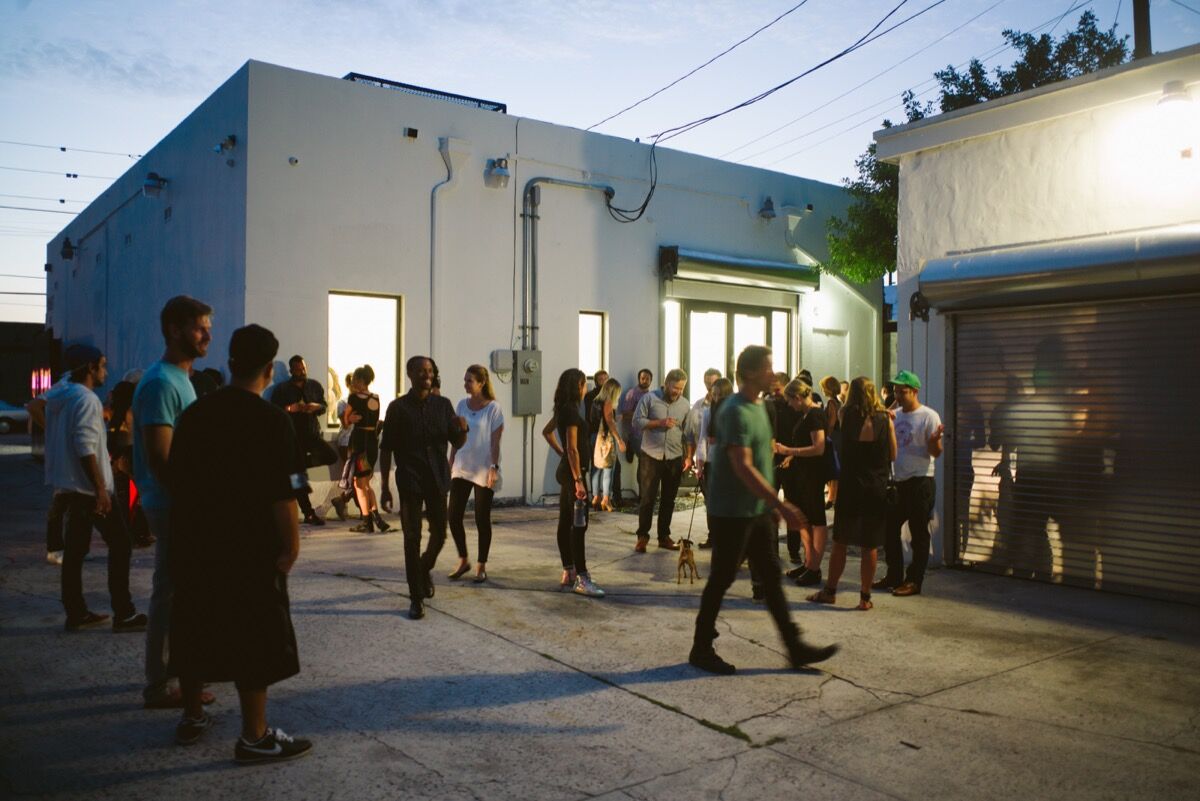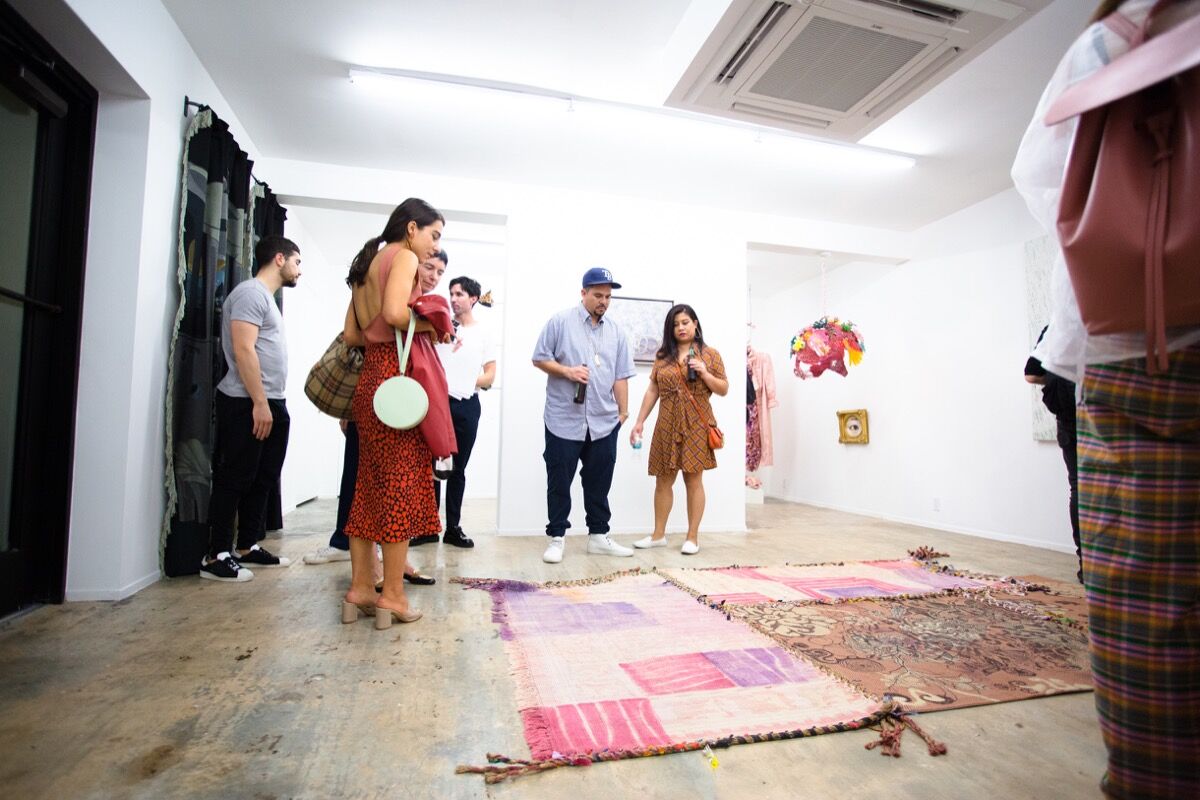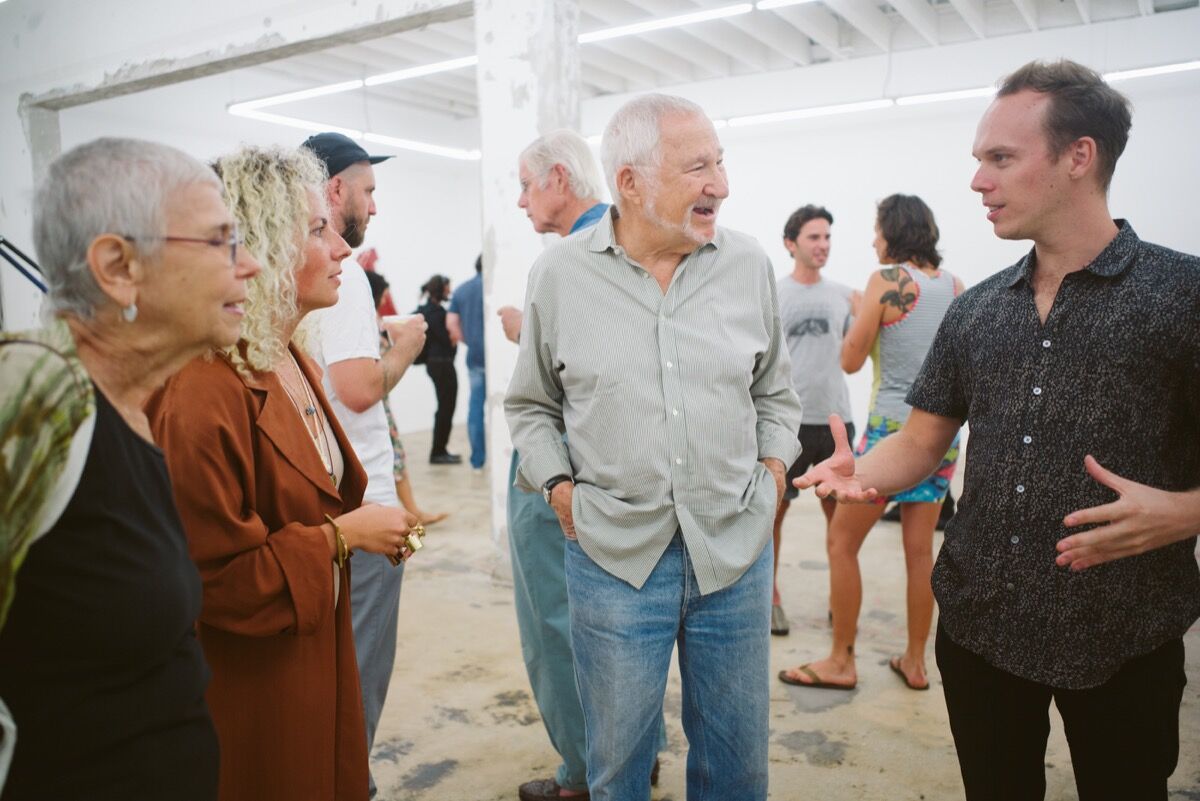
Art Market
What Do Galleries Owe Their Local Communities?

Guests outside Nina Johnson. Photo by Gesi Schilling.
A storm swept through Detroit on July 20th, but it didn’t stop a boisterous crowd from descending on Reyes | Finn. The gallery, located in the Corktown neighborhood, was opening three new exhibitions, coinciding with the second annual Detroit Art Week.
The gallery’s main space was taken up by massive, mixed-media paintings by local artist
; in the outdoor courtyard were a series of sculptures by
, known for making abstract interventions in Detroit’s streetscapes, and large-scale, game-based sculptures by
. There was a different vibe in the air than one would find at a comparatively buttoned-up opening in New York; there was also an ample, free-for-all dinner buffet, courtesy of beloved Madison Heights taco joint Tienda Mexicana.
Reyes | Finn is an interesting place to start thinking about a complicated question: What, exactly, does an art gallery owe the city in which it’s based?
“Detroit is a city in transition—whatever feelings one may have about that, it is happening,” said Bridget Finn, who was formerly a director at Mitchell-Innes & Nash in New York. “[My partner Terese Reyes and I] very much wanted to be there, providing career and financial opportunities for Detroit artists, as that transition progressed.”
That doesn’t mean showing Detroit-based artists exclusively. Finn’s broader goal is to “elevate the conversation around contemporary art” in Detroit. That can mean showing well-known New Yorkers—like the
sculptor
—while simultaneously shining a spotlight on local artists, from
and
to
.
“Most artists who were born and raised in Detroit have a work ethic that is powerful and unique,” Finn said. “For a long time, artists working here were accountable only to their own standards and demands. The art world provided limited opportunities, so people blazed on, tending to their own practices with a focus on owning their craft.”
Galleries like Reyes | Finn can help nurture and professionalize those practices—and introduce Detroit-based artists to a wider audience via participation in tastemaking art fairs like NADA Miami. It’s a delicate balance, and one the gallery seems to be striking nicely. In September, for instance, they’ll be opening a solo exhibition by Detroit native
, a name New York audiences might recognize from her inclusion in the 2017 Whitney Biennial.
Part of what makes the conversation about galleries’ community accountability difficult is how skewed the art world is toward cities like New York and Los Angeles. If a high-profile gallery in Manhattan were to only show artists based in New York, it’s unlikely that anyone would accuse it of being “regional” or “parochial.” Yet a gallery located in Cleveland or Rochester might risk those pejoratives if it maintained a purely local program; meanwhile, if that gallery only showed artists based in global art hubs, it might alienate the community. To further complicate things, an artist based in Cleveland or Rochester might not feel like they’ve “made it” until they’ve secured representation in New York or Los Angeles. In many ways, it would help if critics, curators, and other gatekeepers ditched the halo that surrounds major art world hubs, as if artists living and showing elsewhere haven’t been properly vetted.

Guests in the downstairs gallery of Nina Johnson for the opening of "Of Purism" curated by Charlap Hyman and Herrero. Courtesy Nina Johnson.
For gallerist Nina Johnson of Miami, the whole emphasis on place seems slightly out of touch. “Our sense of what ‘community’ means has changed dramatically in the past 20 or 30 years,” she said. “I don’t know that any of us consider our communities to be geographically specific—rather, it’s more about like-minded individuals working toward common goals. As a gallery we form our own community via the individuals whose work we champion, and that exists across cities and countries.”
Like Reyes | Finn, Nina Johnson’s programming is a mix that includes Miami natives along with talent from Los Angeles (like original
member
) to New York (such as the whimsical sculptor
). In September, she’ll open a solo exhibition by Miami-based
, as well as a survey of paintings by the Florida Highwaymen. Both exhibitions, she said, are “rooted in South Florida history,” yet are “relevant everywhere.” That sweet spot is important to her: “a strong, personal sense of history and place—that connects beyond that, into a global narrative.”
Several dealers I spoke to stressed that there are many ways a gallery can be a good neighbor and active member of a community. The important thing is to have a rigorous, supportive program—regardless of where the artists in one’s stable hail from.
“It’s another way of doing business,” said Jane Beebe of PDX Contemporary Art in Portland, Oregon, when I asked her whether it would be odd for a gallery to primarily show artists who aren’t part of the local scene. “Each gallery should be free to do business in the way it wants, to have the best programming possible.”
Beebe’s gallery roster, she estimated, is evenly split between artists from Oregon, and those from elsewhere. A gallery’s responsibility to the community, she said, has more to do with being a “good partner—contribut[ing] time and money, if possible, to institutions and individual artists.” For her, that’s meant donating the occasional artwork to a local institution, loaning pieces, and committing energy to worthwhile regional initiatives.
Barry Whistler, who runs an eponymous gallery in Dallas, concurred. “My responsibility as a gallery owner is showing quality art,” he said. “Dallas has grown so much in the past 10 years, and that has brought an expansion to the art scene.” Certain art spaces, he noted—including Latino Arts Project and Galerie Frank Elbaz—don’t focus at all on regionally based talent. “This has elevated the art scene and the city of Dallas in a positive way.”
Likewise, David Klein’s namesake gallery in Detroit values dialogue between local artists and the wider art world. “We have a two-fold mission,” Klein said. “There’s a commitment to representing local artists, living and working in the Detroit metropolitan area. And there’s a commitment to bringing the work of artists from outside the region to Detroit, so that the audience here is exposed to work that is national or international in scope.”
He added: “Galleries need to be inclusive of the community, not exclusive, and we have found our Detroit neighbors to be curious and interested in what we’re doing here.” That goes for an exhibition by someone who lives nearby—like
, who makes photographs and sprawling installations out of the city’s industrial cast-offs—as well as for shows by renowned outside artists like Los Angeles’s
.

Emmett Moore with guests at the opening of his exhibition "Fractured." Photo by Gesi Schilling.
For Megan Bradley, director of Montreal’s Parisian Laundry, the right balance involves a mix of local and imported talent. “I often try to pair a local artist with an invited artist, to ensure that people come out to see the shows,” she said, “as there’s still a bit of that lingering sensibility—that people inevitably like what they know, or want to see local names they recognize.” But, she added, “this has changed over the years, and as I’ve persisted with this type of programming, my collector base [has become] more and more adventurous.”
Echoing Nina Johnson, Bradley also noted that “place” itself can be a malleable concept. Ample studio space and a lower cost of living make Montreal a destination for artists from across Canada. “One of the very elemental things about being a ‘Montreal artist,’” she said, “is that many of them are not actually from Montreal, making the scene diverse and interesting.”
Ultimately, a gallery’s investment in its home base involves more than the percentage of artists on its roster who are “local.” And as a city’s art scene matures, it’s important to have a balanced ecosystem—one that can support regionally-focused projects as well as galleries mounting shows by artists from other cities or countries. The real responsibility for dealers is to maintain a sense of respect, nuance, and engagement.
If that’s not happening, a gallery is likely to feel the ire of its neighbors. Consider one West Coast dealer—who shall remain nameless—recently roasted on Facebook. “She doesn’t show any local artists, is largely disengaged from the local art community, and her gallery is often closed because she’s out of town,” an armchair critic wrote. “From the day she started her gallery, it’s been pretty clear that she views [the gallery’s longtime home base] as being too small for her ambitions and wants to be somewhere bigger.”
Conversely, a gallery trying to win the respect of its community should be able to show its commitment to where it’s based; that this is a conscious choice, not just a weigh station en route to an art-world center. “Reyes | Finn didn’t drop into Detroit in some sort of Wizard of Oz, ‘the gallery has landed’” scenario, Finn joked. Instead, she and her partner have built up a program that makes sense in the city, one that seeks to be responsive to the pulse of the local art scene and act as a hub, connecting Detroit with broader conversations and practices.
Likewise, Manuela Paz and Christopher Rivera opened Embajada in San Juan, Puerto Rico with an eye to strengthening the island’s art scene and its economy.
“We’re firm believers in being responsible community members and business owners,” Paz said, “especially given the fact that galleries play a role in gentrification. We take ethical responsibility very seriously. This means not only supporting local artists but also supporting and promoting local and independent businesses whenever possible.”
While their roster boasts a majority of Puerto Rican artists, Paz and Rivera stressed the importance of inviting artists from beyond the island to stage exhibitions and projects there. And they’re helping to provide a platform for local talent to gain acclaim on a wider stage: Daniel Lind-Ramos, an artist they represent, is a stand-out of the 2019 Whitney Biennial.
Perhaps the true mission of any gallery is simply to help tap into and contribute to the larger, interconnected story of contemporary art.
“I don’t want to be considered regional—yet I want to support my local community of artists, and offer some reflection of what is going on here,” said Bradley of Parisian Laundry. “Part of this responsibility is providing them with opportunities to converse and show alongside artists from elsewhere.”
Scott Indrisek is a contributing writer for Artsy.
No comments:
Post a Comment